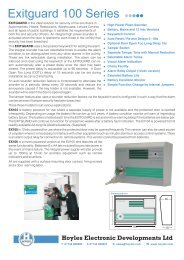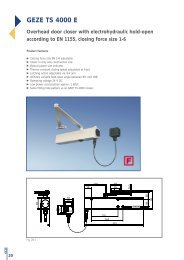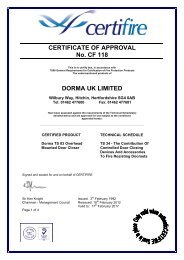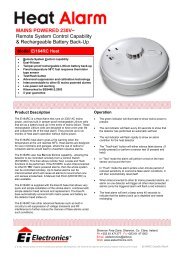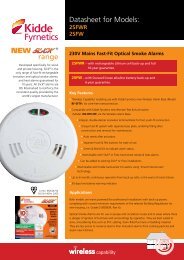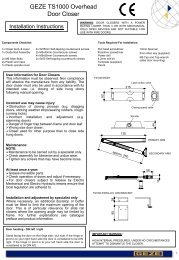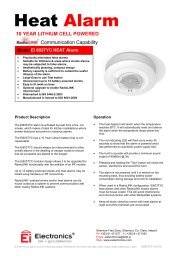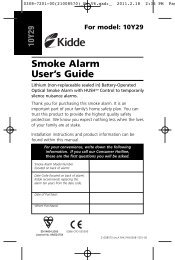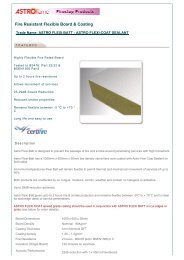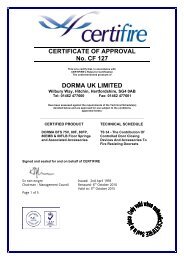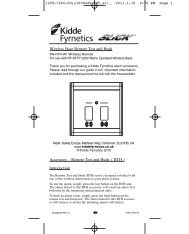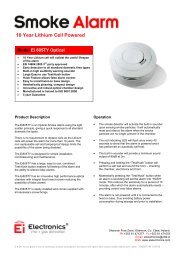Hard Wired Carbon Monoxide Alarms For Homes - Safelincs
Hard Wired Carbon Monoxide Alarms For Homes - Safelincs
Hard Wired Carbon Monoxide Alarms For Homes - Safelincs
Create successful ePaper yourself
Turn your PDF publications into a flip-book with our unique Google optimized e-Paper software.
HEATCARBONMONOXIDESMOKEEN50291: 2001SMARTINTERCONNECT))Kidde FyrneticsKidde Fyrnetics manufactures 24 million CO, smoke and heatalarms every year and has unrivalled expertise and commitment toongoing research and development – with the resources to matchas part of the $37 billion United Technologies (UTC) group. Ouralarms are all Kitemarked and made in our ISO 9001 and 14001certified factories. We have unrivalled expertise in CO detection,particularly in the USA where this problem has now been addressedby legislation.The launch of our new range of hardwiredcarbon monoxide alarmsspecifically for the UK market followsextensive development and testing. Therange consists of two models: 423/9HIRand the digital alarm 423D/9HIR.))New feature-packed<strong>Hard</strong>-wired CO alarmsFeatures of both models:Our new range of hard-wired CO alarms consists of twomodels: 423/9HIR and the digital alarm 423D/9HIR. Bothshare an extensive range of features including:))) mains powered with sealed-in, rechargeable lithiumcells for back-up preventing tenant access))) electrochemical sensor sampling air every 15 seconds– safer than others sampling every 60 seconds))) unique Smart Interconnect allowing Kidde Fyrneticshard-wired smoke, heat or CO alarms to be linkedon one wiring network))) neat circular design can be ceiling or wall mounted))) product life of 7 years from initial power up and fullguarantee for 6 years))) quickly connects with snap-on harness and unit locksin place by default))) easy to use test/reset buttons))) relay pattress option allows operation of otherdevices))) separate easy to follow user and installer manualsincluded and also available on our websiteFeatures of the 423D/9HIR model:))) digital display showing the parts per million(ppm) when CO is detected, calculating theppm and length of exposure time))) peak recall feature can be used to call up thehighest level (above 30 ppm) recorded sincethe button was last pressed))) memory recall feature enables users to verifyif there has been a CO incident in theirabsence which had ceased before their return
CO and human healthEffects of CO concentration over timedemonstrating why CO alarms need to monitor bothconcentration and durationThe graph shows that a low level ofCO exposure over several hours isjust as lethal as a short-term highexposure level.According to the Health and Safety Executive, carbon monoxide(CO) poisoning causes an estimated 50 deaths and 200 seriousinjuries annually in Britain. Other organisations have recordedhigher fatality and injury levels and all these figures reflect justwhat we know about: CO poisoning is certainly underdiagnosedby doctors and often not recognised by coroners, asit simulates other conditions.CO is odourless and colourless. It bonds with haemoglobin inthe blood to gradually replace essential oxygen, preventing theuptake of oxygen into the blood, resulting in headaches,nausea, unconsciousness – and finally death. While exposure tohigh concentrations leads to collapse, long-term exposure tolower concentrations can result in symptoms similar to flu orfood poisoning. As the chart shows, lower level exposure overa longer period can prove fatal just as higher level, short-termdoses. Surviving victims of CO poisoning may well be leftpermanently unwell and disabled through neurologicaldamage.Key50% COhb Death45% Coma/brain damage40% collapse35% vomiting30% drowsiness25% Nausea+headache20% headache15% mild headache10% none5% noneCO alarms – standardssiting CO alarmsThe current standard for carbon monoxide alarms, BS7860, willcease to apply in April 2006 being replaced by EuropeanStandard BS EN 50291:2001 – a much tougher standarddesigned to increase safety and improve product integrity.This incorporates aspects of the US standard UL2034 andrequires CO alarms to trigger at lower concentrations thanpreviously. While all newly designed CO alarms must comply,existing alarms complying only with the old BS are stillavailable. Another newstandard, BS EN 50292,will apply to selection,installation, use andmaintenance – includingsiting.The number and locations of CO alarms will depend upon thedwelling layout. It is essential that carbon monoxide reaches thealarm from the source to trigger it and the alarm sounder must becapable of waking sleeping occupants. To achieve this with just oneunit is difficult and a network of interlinked alarms – for examplewith the Kidde Fyrnetics Smart Interconnect feature - is preferable,with one alarm in each sleeping area and at least one on every level.CO alarms should never be installed in bathrooms, shower rooms,boiler rooms or garages.The optimum positioning of a CO alarm within a room is discussedin the Kidde Fyrnetics CO alarm installation manuals and the latestinstallation standard, BS EN50292. This makes use of workdone by the BRE which showsthat CO is normally emittedwarm and so will tend to flowATTIC OFFICEBEDROOM BEDROOM BATHROOMupwards, determining bestLIVING ROOMKITCHENGARAGElocations as upper wall level orceilings. The new KiddeHEAT ALARMCARBON MONOXIDEION ALARMOPTICAL ALARMKidde Fyrnetics CO alarms are alsosuitable for ceiling mounting thanksto their circular shape.Fyrnetics range can be ceiling orwall mounted.ALARMDO NOT FIT
EN50291: 2001)) SMART INTERCONNECTDomestic alarms fulfil two essential functions: sensingcarbon monoxide or a fire incident, then alerting occupantsto danger with a loud sounder and other indicators. Theunique Smart Interconnect feature enables a number ofKidde Fyrnetics hard-wired CO, smoke or heat alarms to beinterconnected within a home. When a smoke/heat alarm istriggered by a fire or a CO alarm by carbon monoxide, allthe alarms activate to alert occupants of danger, givingwhole property protection. The new hard wired CO alarmshave different, distinct alarm sounder patterns for carbonmonoxide and fire - supported by different digital displaymessages on the 423D/9HIR model.technical specificationModels –423/9HIR and 423D/9HIRBS Kitemarked to BS EN 50291: 2001CO Sensor –ElectrochemicalElectrical rating – 230V AC; 50Hz; 30mA max per alarmBack-up – 8.2VAudio Alarm – 85 dB at 3mTemperature Range – 4 o C to 38 o CHumidity Range – 5% to 95% RHWiring –in accordance with the latest IEERegulations, BS7671, via a suppliedcable harnessDimensions – base diameter 144mm; alarmdiameter 147mm; depth 42mmWeight –350gGuarantee – 6-yearsReplacement – 7 years after commissioningThe SMK23 Surface Pattress can be used if necessary.activation times related to CO levelsCO Concentration Activation timeParts per million (ppm): (mins):
ecognised sources ofCO in the homeCO can be produced by any fuel burning appliances resulting from theincomplete combustion of carbon based fuels including bottled or mainsgas, coal, oil and wood. Typical appliances include boilers, water heatersand wood burning stoves, as well as extended use of appliances such asfireplaces and ovens. Other unfixed appliances introduced by occupiers arealso a danger, including LPG and paraffin heaters, clothes dryers andcharcoal or gas grills and hibachis operated in enclosed spaces.With fixed appliances, problems often occur from blockages and backdraftsin flues or loose, blocked or inappropriate vent pipes. Indications ofproblems include slow burning or extinguished solid fuel appliances,sooty stains around the appliance or orange/yellow gas flames insteadof blue. Cars running in open or enclosed garages, particularly whenintegral or attached to the house, also pose a threat, especially when belowa bedroom.OpenfireplacesCars ingaragesBlocked fluesand ventsGas or oilboilersGas clothesdryersLPG/paraffinheatersCookingrangesGas cookersthe wider risk from COThe main difficulty with CO is that the dangers are often far from obvious.Shared flues can cause unexpected problems and there have been instancesof CO from flues discharging onto common areas effecting neighbouringproperties, whether alongside or above the source – sometimes with lethalconsequences. In other cases, flue outlets have been interfered with by, forexample, ‘pirate radio’ station operators while fixing illegal antennae onapartment blocks. A wide diversity of other CO poisoning sources have alsobeen recorded ranging from barbecues operated in confined spaces to fastfood shop outlets effecting neighbours.In addition to poor maintenance or sub-standard fittings, flues and vents,other factors can have a serious impact. These factors include wind directionand velocity (particularly gusts), temperature inversion (where exhaust gasescan be trapped near the ground), negative pressure from exhaust fans andsimultaneous operation of several appliances (which then compete forinternal air for combustion).susceptible propertiesAs the UK government’s Chief Medical Officer has stressed – CO poisoningcan occur in any type or age of property, including brand new, owneroccupiedhousing. The idea that it is limited to just older buildings, poorerhouseholds and student ‘digs’ is entirely false.Today, things are also being made worse by installation of double-glazingand the sealing up of buildings for energy conservation, so reducing scopefor air intake. Further changes to Part L (energy conservation) and Part F(ventilation) of the Building Regulations – and similar measures in Scotland- will continue this trend in new homes. Here, moves towards air-tightbuildings with controlled ventilation will make the domestic environmentmore sensitive to air pressure changes, so increasing the risk of CO fromheating appliances.the case for CO alarmsWhile nothing can replace an effective heating maintenance programme,the case for CO alarms is compelling. In both public and private rentedsectors, landlords are increasingly encountering tenant-resistance to accessfor regular heating inspection and maintenance. In owner occupiedproperties, there is no compulsion for heating installations to bemaintained.In any event, as we have seen a huge diversity of factors can lead to thepresence of CO in any home – new or old – and it is impossible to predictand prevent all possible scenarios. The latest CO alarms provide an audiblewarning at exposure levels well below those critical to healthy adults andare invaluable in the fight against CO poisoning. <strong>For</strong> the low costsinvolved in fitting CO alarms, there really is no reason preventing theirwidespread use.decent homes and HHSRS<strong>For</strong> social housing, the government intends to replacethe Decent <strong>Homes</strong> ‘Fitness Standard’ (which did notrefer to carbon monoxide poisoning) with the HousingHealth and Safety Rating System (HHSRS) whichfocuses more on health and safety risks. The publishedHHSRS specifically identifies carbon monoxide andfuel combustion products as ‘Category 1’ hazards andspecifies properly sited and maintained CO alarms asan optimum preventative measure for landlords tocarry out.The government will require that a ‘decent home’ is free of all Category 1hazards and seeks to ensure that all social housing meets the standard by2010. The HHSRS also provides a useful benchmark for assessing housingstandards in the private sector.legislation and legalresponsibilitiesThere are currently no Building Regulations requiring CO alarms in anyhomes and urgent action is needed to prevent the continuing toll of deathsand serious injuries which occur despite our strong gas safety and heatinginstallation regulations. The UK is not alone in being confronted with thisproblem. In the USA, similar proportions of the population to the UK arekilled or injured by CO (in 2003, 13 people died in New York alone) but – incontrast to the UK - a growing number of American states are now makingCO alarms mandatory in virtually all housing.As a first step, CO alarms should be fitted in all registered social housingproperties and consideration given to the private rented sector as well, asthese are most at risk. But an addition to the Building Regulations to requirehard-wired CO alarms in all homes must surely be the eventual goal. Evenin the absence of specific legislation, landlords have a responsibility todayunder civil law to take reasonable steps to protect tenants and facesubstantial damages in the event of CO poisoning. Kidde Fyrnetics hasobtained an expert legal opinion on this, available on request.
<strong>Hard</strong>-wired <strong>Carbon</strong> <strong>Monoxide</strong> <strong>Alarms</strong>Model no Display AC Memory Wall or Rechargeable Unit/Back up Dimensions Hush Interconnectable toWindow Power Ceiling back-up guarantee button Kidde hard-wiredMountsmoke & heat alarms423D/9HIR ✓ ✓ ✓ ✓ ✓ 6 years 146 x 46 ✓ ✓423/9HIR – ✓ – ✓ ✓ 6 years 146 x 46 ✓ ✓Battery Powered <strong>Carbon</strong> <strong>Monoxide</strong> <strong>Alarms</strong>Model no Display Power Memory Wall or Ceiling Unit Dimensions Hush Interconnectable toWindow Mount guarantee button Kidde hard-wiredsmoke & heat alarms9CO5UK – DC – ✓ 5 years 140 x 38 ✓ –900-0146UK ✓ DC ✓ ✓ 5 years 140 x 38 ✓ –SLICK ® fast-fit <strong>Hard</strong>-wired Smoke and heat alarmsModel no Alarm type AC Alkaline Rechargeable Unit Back-up Hush InterconnectPower back-up back-up guarantee guarantee button x12 x241SF23/9HIR Ionisation ✓ – ✓ 10 years 10 years ✓ – ✓1SF23/9HI Ionisation ✓ ✓ – 6 years – ✓ – ✓2SF23/9HIR Optical ✓ – ✓ 10 years 10 years ✓ – ✓2SF23/9HI Optical ✓ ✓ – 6 years – ✓ – ✓3SF23/9HIR Heat ✓ – ✓ 10 years 10 years ✓ – ✓3SF23/9HI Heat ✓ ✓ – 6 years – ✓ – ✓Original range <strong>Hard</strong>-wired Smoke and Heat <strong>Alarms</strong>Model no Alarm type AC Alkaline Long life back-up Unit Back-up Hush InterconnectPower back-up guarantee guarantee button x12 x24123/9HILL Ionisation ✓ – ✓ 10 years 10 years ✓ – ✓123/9HI Ionisation ✓ ✓ – 6 years – ✓ – ✓123I Ionisation ✓ – – 6 years – – – ✓223/9HILL Optical ✓ – ✓ 10 years 10 years ✓ – ✓223/9HI Optical ✓ ✓ – 6 years – ✓ – ✓223I Optical ✓ – – 6 years – – – ✓323/9HILL Heat ✓ – ✓ 10 years 10 years ✓ – ✓323/9HI Heat ✓ ✓ – 6 years – ✓ – ✓Interconnectable DC Powered Smoke <strong>Alarms</strong>Model no Alarm type AC Alkaline Long life back-up Unit Back-up Hush InterconnectPower back-up guarantee guarantee button x12 x2419HILL Ionisation DC – ✓ 10 years 10 years ✓ ✓ –19HI Ionisation DC ✓ – 5 years – ✓ ✓ –29HILL Optical DC – ✓ 5 years 5 years ✓ ✓ –29I Optical DC ✓ – 5 years – – ✓ –= Sealed inICO/6PA4/Hod/805Kidde Safety Europe, Mathisen Way, Colnbrook, Berkshire SL3 0HBT: 01753 685148 F: 01753 685096 www.smoke-alarms.co.uk



